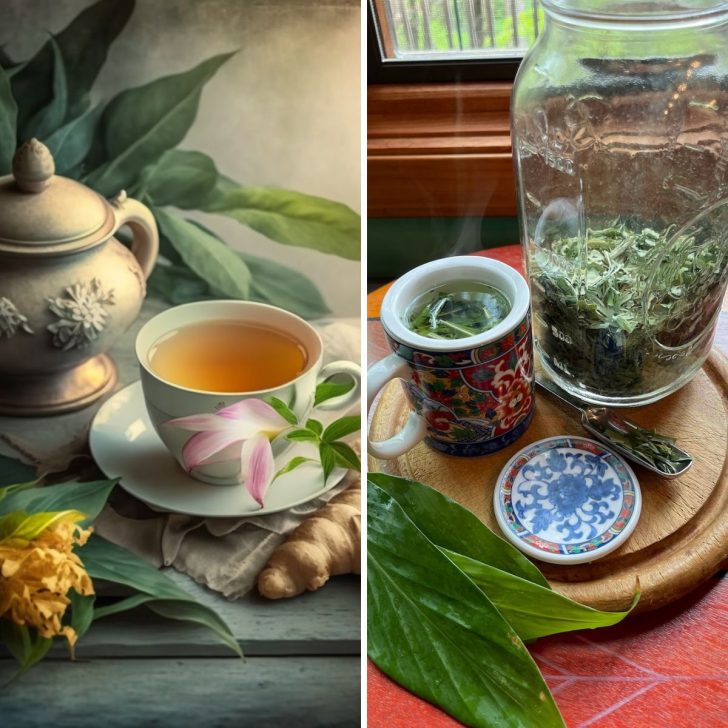We love growing, foraging, harvesting and preserving many different herb and plant leaves, roots, flowers and fruit to use for herbal teas. So when my son was pruning his ginger plant of her gangly stalks, I seized the opportunity to dry them in order to make ginger leaf tea.
Not only is ginger leaf tea pleasant and soothing, with a mild ginger flavor, but there are many reasons to enjoy ginger leaf tea.
If you don’t want to know about edible types of ginger, or complementary ingredients for ginger tea blends, you can skip straight to some ginger leaf tea recipes here.
Not only is ginger leaf tea soothingly tasty, but we cover some of the many reasons to make ginger tea in this article on the many benefits and uses of ginger leaves.
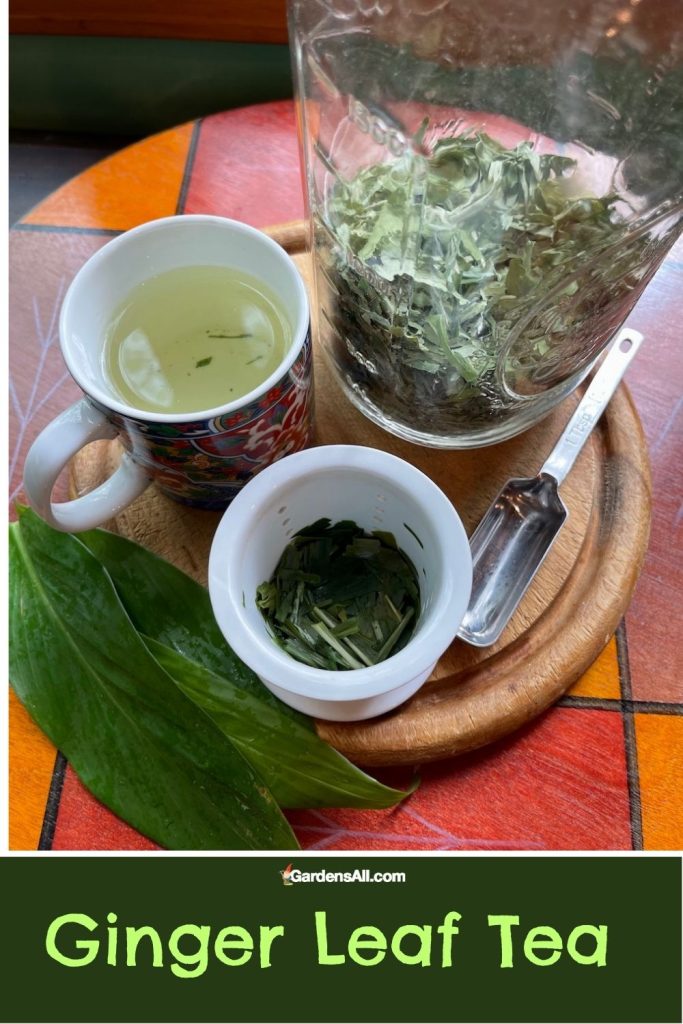
Ginger Varieties You Can Use for Ginger Leaf Tea
While the most popular and flavorful ginger plant for the ginger root is the common ginger, Zingiber officinale, many other ginger varieties are also edible with medicinal benefits and uses. Next, we list a few of those varieties.
Edible Ginger Varieties
Here are six most common ginger varieties that can be used for ginger leaf tea.
- Common ginger or culinary ginger, (Zingiber officinale): This is the most widely used ginger variety for cooking and making tea. It has a strong, pungent flavor and aroma that adds a spicy kick to any dish or beverage.
USDA hardiness zones 9-12. - Shell ginger or pink porcelain lily, Alpinia zerumbet): This variety of ginger has a milder and sweeter taste than common ginger and is often used in Japanese cuisine. It has a delicate floral aroma and can be used to make a refreshing and soothing tea. Studies show this to have the usual medicinal benefits of ginger, and in addition, shell ginger has been found to play an important contributory role in the longevity of people in Okinawa.[1]https://www.ncbi.nlm.nih.gov/pmc/articles/PMC6616534/
USDA hardiness zones 8-11. - Turmeric, (Curcuma longa): Although turmeric is not technically a type of ginger, it belongs to the same family (Zingiberaceae) and has a similar flavor and health benefits. Turmeric has a warm, earthy flavor and can be used to make a vibrant and nutritious tea.
USDA hardiness zones 9-11. - Galangal or Thai ginger, (Kaempferia galanga): Galangal is a rhizome that has a distinct flavor and aroma, similar to a combination of ginger and pepper. It is commonly used in Southeast Asian cuisine and can be used to make a spicy and aromatic tea.
USDA hardiness zones 9-11. - Japanese ginger or myoga, (Zingiber mioga): This ginger variety is commonly used in Japanese cuisine, especially in pickles and salads. It has a mild and slightly sweet flavor and can be used to make a refreshing and subtle tea.
USDA Hardiness Zones 6a-9b, (possibly colder).[2]https://www.plantdelights.com/collections/zingiber-ginger-plant - White Butterfly Ginger, (Hedychium coronarium): I don’t know if this is one of the most common gingers for leaf tea. However, this is the ginger plant my son is growing so these are the ginger leaves we’re using for making ginger leaf tea. They definitely have that familiar ginger fragrance and taste and are just the right pleasingly mild ginger flavor for herbal tea.
USDA hardiness zones 7-10.
Shell ginger, Alpinia zerumbet, has been found to play an important contributory role in the longevity of people in Okinawa.
REFERENCES: Ginger studies[3]https://www.ncbi.nlm.nih.gov/pmc/articles/PMC6616534/
What Parts of the Ginger Plant Are Edible?
All parts of the ginger plant are edible and can be used for tea. Here’s an image of our son’s white butterfly ginger plant that we pruned and then dried the leaves and stems for making ginger leaf tea.

Ginger Leaf Tea Options
When it comes to herbal tea blends, the options are pretty much endless. And so it goes with ginger leaf tea, which means that you can use any herbs, roots, leaves, flowers and fruit that you enjoy or have on hand.
So you can have fun experimenting with blends, but be sure to write down the combinations you enjoy most so that you can replicate them. I’ve made the mistake of not doing that and it can be hard to nail that specific combination again when you do “a little of this and a little of that” kind of blending! With all tea recipes, you can adjust the quantity of herbs and water to be more or less, depending on whether you like it stronger or milder. We tend to like to make them stronger, because it’s easier to dilute it than to add herbs once it’s all been infused.
Herbs, Flowers and Dried Fruits That Go Well With Ginger Tea
Here’s a great starter list of complementary ingredients to try with your homemade ginger leaf tea. Likely you will discover others, (and this list doesn’t even touch on the spices you might try)!
These complementary ingredients are listed alphabetically rather than by type of ingredient.
Ginger Leaf Tea is Compatible With These and More:
- Apple
- Avocado leaves
- Banana peels, dried
- Black tea
- Blueberries
- Chamomile
- Citrus
- Elderberries
- Mango fruit
- Mint
- Raspberries
- Rose petals
- Roselle
- Strawberries
- Strawberry leaves
- Wild Violets
Dried banana peels can add sweet flavor to teas, plus there are numerous health benefits of banana peels. Similarly, wild violets are a beneficial and sweet addition as well, (see also, our article on wild violets tea). Honeysuckle flowers can also be a kindred combination for ginger tea.
See also, honeysuckle tea and honeysuckle benefits.
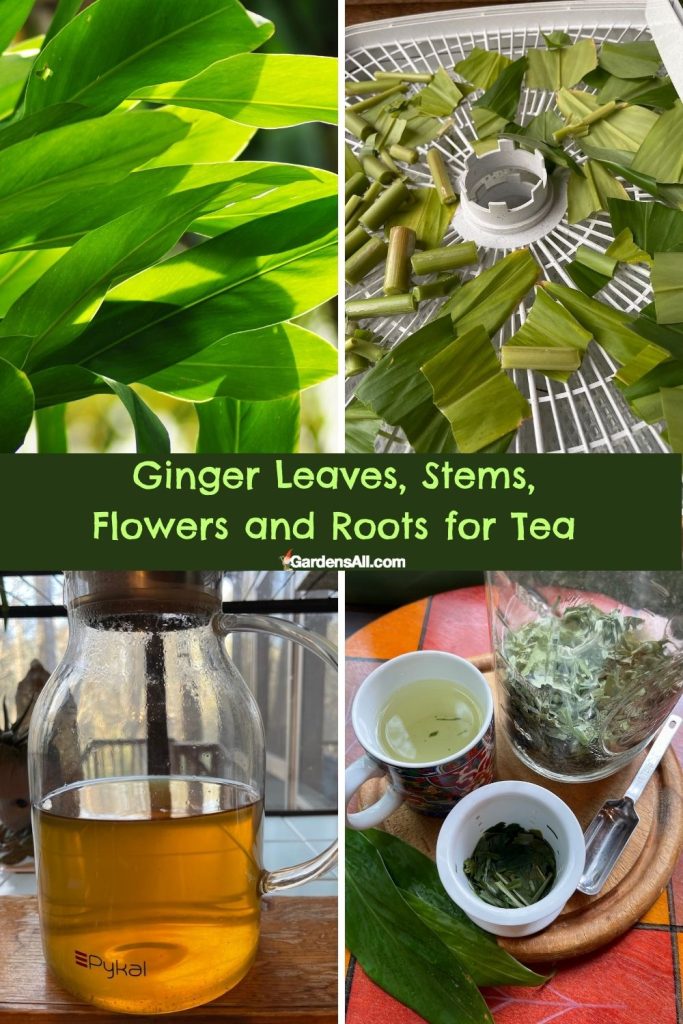
Ginger Leaf Tea Recipes
Ginger leaf tea is a delicious and healthy beverage that can be made using fresh or dried ginger leaves. Here are two recipes for ginger leaf tea, one using fresh ginger leaves and another using dried ginger leaves.
Many teas are traditionally made by boiling the plant parts for around 20 minutes. However, heating at temperatures over 120°F destroys most vitamins, so we prefer to steep by pouring near boiling water over the leaves so as to help retain vitamins, while steeping for 10 minutes minimum.
So I’ve added that note within the instructions for each below.
Fresh Ginger Leaf Tea
2-4 Servings
Ingredients:
- 8-10 fresh ginger leaves
- 4 cups of water
- Honey (optional; can use your sweetener of choice)
Instructions:
- Rinse the ginger leaves in cool water to remove any dirt or debris.
- In a medium-sized saucepan, bring 4 cups of water to a boil.
- Add the ginger leaves to the boiling water.
- Reduce the heat and let the mixture simmer for 10-15 minutes.
- Remove the pot from the heat and let the mixture cool for 5 minutes.
- OR, alternately, we prefer to steep by pouring near boiling water over the leaves so as to help retain vitamins, then steep for 10 minutes minimum.
- Strain the tea to remove the ginger leaves.
- Sweeten the tea if desired.
- Serve tea hot or cold.
Dried Ginger Leaf Tea
2-4 Servings
Ingredients:
- 4 tablespoons of dried ginger leaves
- 4 cups of water
- Honey or sugar (optional)
NOTE: Beyond your personal preferences for stronger or milder brews, keep in mind that the bulkier your herb, the more you’ll need, and vice versa: the finer ground or powdered is your dried leaves, the stronger the brew. We use double or more, because our leave are coarsely crushed, which leaves a lot of air space, so more is needed.
Instructions
- In a medium-sized saucepan, bring 4 cups of water to a boil.
- Add the dried ginger leaves to the boiling water.
- Reduce the heat and let the mixture simmer for 10-15 minutes.
- Remove the pot from the heat and let the mixture cool for 5 minutes.
- OR, alternately, we prefer to steep by pouring near boiling water over the leaves so as to help retain vitamins, then steep for 10 minutes minimum.
- Strain the tea using a fine mesh strainer to remove the ginger leaves.
- Sweeten the tea if desired. We like to use homegrown dried stevia leaves, honey or maple syrup.
- Serve the tea hot or cold.
Note: You may be able to find dried ginger leaves at health food stores or online, but it’s not as commonly known as the ginger rhizome. We didn’t see them on Amazon but did find them on Ebay.
The flavor of dried ginger leaves may be stronger than fresh leaves, so adjust the amount of leaves you use according to your taste. You can also add other herbs or spices like mint or cinnamon to enhance the flavor of the tea.
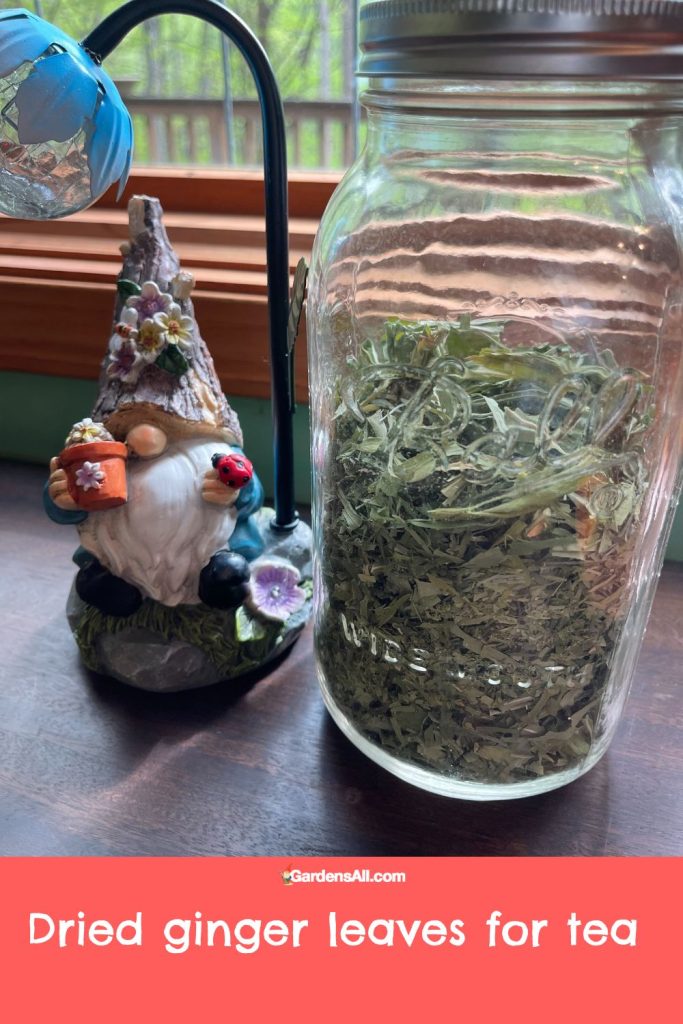
Ginger Leaf Tea Using Ginger Leaves, Roots and Flowers
If you don’t have all of these on hand, you can make ginger tea with any one or more of these ingredients.
Ingredients:
- A handful of fresh ginger leaves, roughly chopped (or 1/4 cup dried)
- 1-2 inches of fresh ginger root, sliced
- 1-2 ginger flowers (optional) (or 2 Tbsp. dried)
- 4 cups of water
- Honey or sugar (optional)
Instructions:
- Rinse the ginger leaves (if using fresh), ginger root, and ginger flowers in cool water to remove any dirt or debris.
- Slice the ginger root into thin pieces and set aside.
- In a medium-sized saucepan, bring 4 cups of water to a boil.
- Add the sliced ginger root and chopped ginger leaves to the boiling water.
- Reduce the heat and let the mixture simmer for 10-15 minutes.
- Remove the pot from the heat and let the mixture cool for 5 minutes.
- OR, alternately, we prefer to steep by pouring near boiling water over the leaves so as to help retain vitamins, then steep for 10 minutes minimum.
- Strain the tea using a fine mesh strainer or cheesecloth to remove the ginger leaves, ginger root, and ginger flowers.
- Sweeten if desired.
- Serve the tea hot or cold.
NOTE: Ginger flowers can add a pleasant floral flavor and aroma to the tea. You can also use dried leaves, root, and flowers if fresh ones are not available.
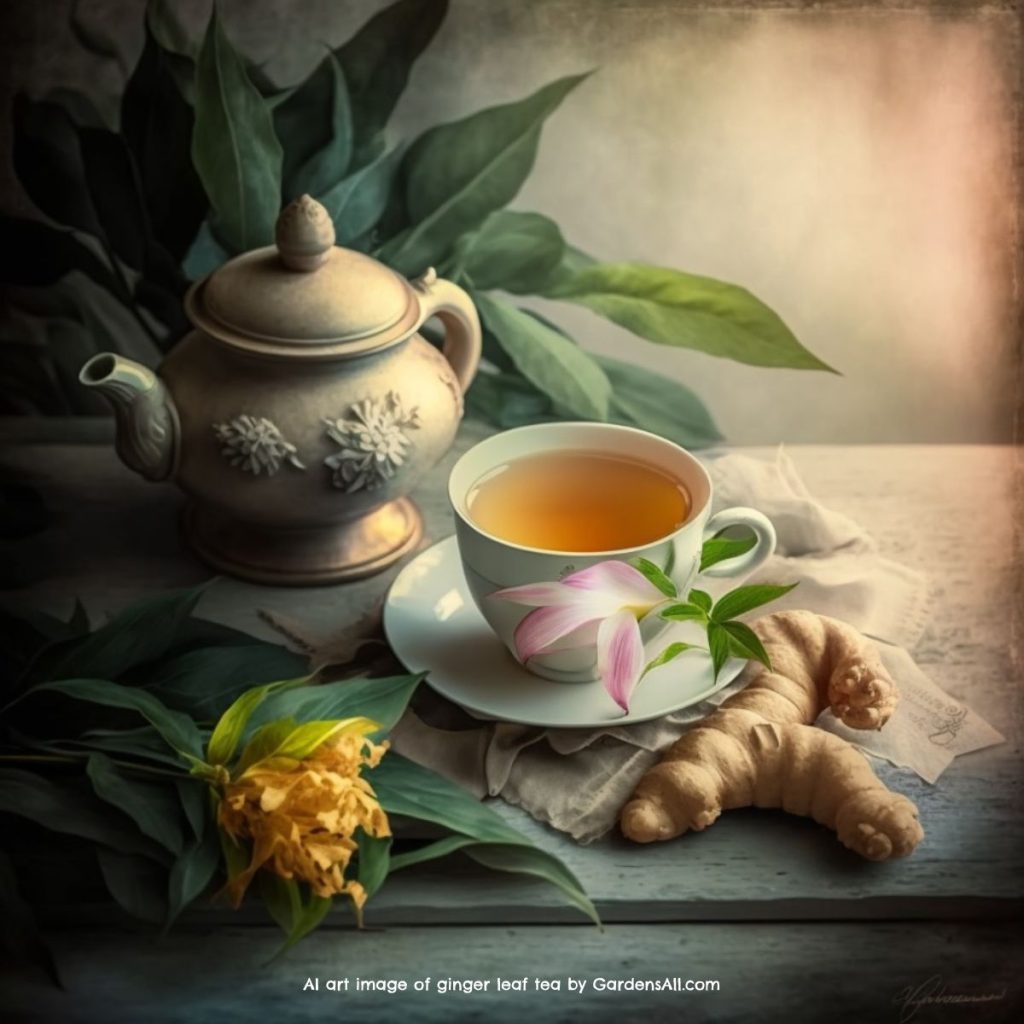
Ginger Leaf Tea With Lemon Mint and Mugwort
We just made this ginger leaf tea with mugwort, lemon balm (in the mint family) and dried stevia leaves, and it’s delicious!
The following recipe are quantities we used for a half gallon tea pitcher, and makes a great tea, hot or cold. We used loose teas and stevia that we grew, harvested and dried, (or a combination of loose and teabags, but you can also use only teabags in the approximate ratios.
Ingredients:
- 1/2 cup loose lemon balm (or 8 teabags)
- 1/2 cup loose ginger leaves (or 8 teabags)
- 1/4 cup loose mugwort (or 4 tea bags) (see mugwort benefits)
- 1 tablespoon stevia leaves (or 1/2 Tbsp. powdered Stevia, or your favorite sweetener to taste, or omit altogether)
Instructions:
- Bring water to boil (or just below a boil).
- Add all of the dried herbs plus stevia (if using it) to a 4 cup measuring cup.
- Pour hot water over the herbs to cover, give them a stir to make sure they’re all covered by water.
- Steep for approximately 10 minutes or more, (it’s fine to leave it for hours too (and even overnight, refrigerated, if you won’t need it right away or plan to use it cold).
We strain it into a larger measuring cup first, then pour that into our tea pitcher, because our 2 quart tea pitcher has a narrow neck which makes it hard to strain into, but if you have a wide mouth pitcher you can strain yours directly into that from your measuring cup.
For more on edible ginger plants, this is a very good and well researched article on hardy gingers.
If you want to be inspired while sipping your medicinal teas, we think you’ll enjoy reading this article on use of ginger leaves.
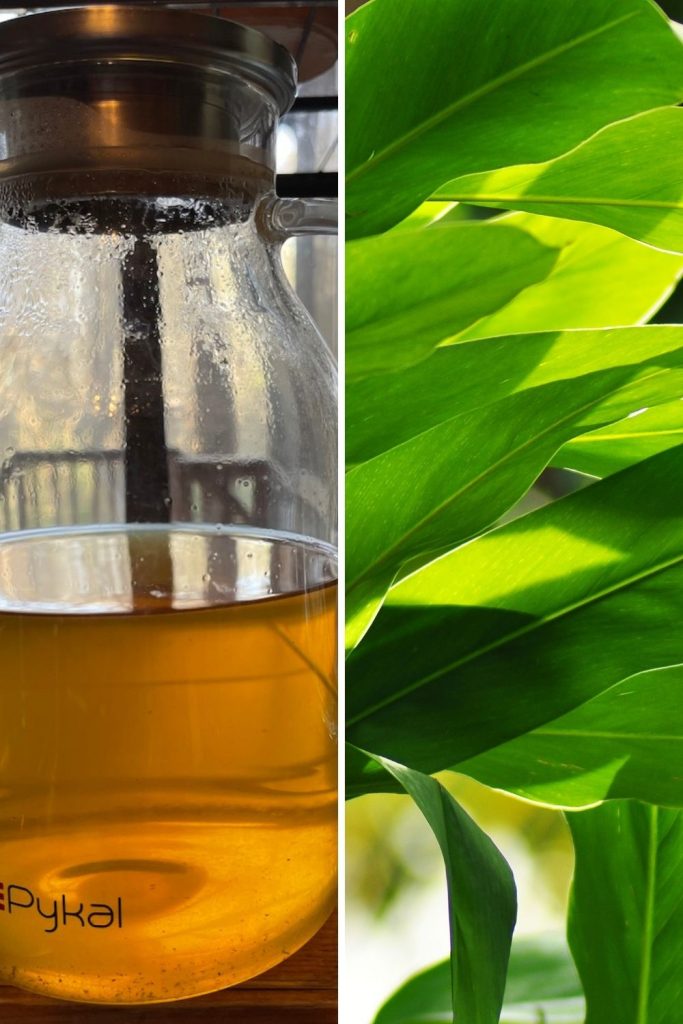
I’m LeAura Alderson, a garden, herb and plant enthusiast with a passion for discovering the many edible and medicinal benefits of the plants all around us, including the weeds! I’m a writer, editor and media publisher for our family of websites.
While I was certified in fitness and life coaching, I am NOT a health practitioner. However, I’m a lifelong health enthusiast, with a keen interest in healthy, organic foods and making home remedies and the content we share is from our own experience and usage as well as that extracted from scientific research so that you can explore further on your own.
Always seek the advice and guidance of your health practitioners first and foremost.
As a family we’re steadily expanding our gardening, experimentation and knowledge around all things gardening, edible landscaping, fresh organic foods and self sustainability with farming in our future. I also own and manage iCreateDaily.com, a site all about transformation through creation, and the power of positivity, optimism and mindset.
References

